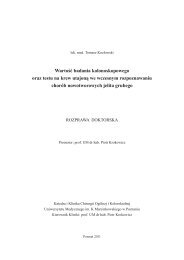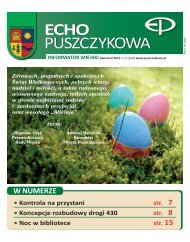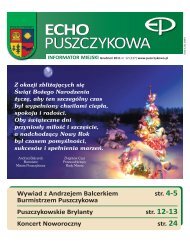MILITARY PHARMACY AND MEDICINE
MILITARY PHARMACY AND MEDICINE
MILITARY PHARMACY AND MEDICINE
Create successful ePaper yourself
Turn your PDF publications into a flip-book with our unique Google optimized e-Paper software.
© Military Pharmacy and Medicine • 2012 • 4 • 3 – 16Jerzy Z. Nowak: Age-related macular degeneration (AMD): a critical appraisal …various intensity or gradual loss of color vision,“warping” of perceived images [10,11]. Early formof AMD is often referred to as age-related maculopathy(ARM).When the eyes are open, photoreceptors arecontinuously working, absorbing light photonsand “recording” the image of the environment.Similarly to TV cameras being turned on, eyesrecord this image in an automatic fashion, generatingthe first signal of a complex, multisynapticvision process. Photoreceptors’ outer segments(POS), filled with visual pigment molecules, arecharacterized by significant functional dynamics;they wear off upon continuous function and,as a consequence, the apical fragments are constantlyshed and captured by neighboring RPEcells. At the same time, POS is being rebuilt inorder to maintain appropriate size (which is animportant parameter determining the efficacyand survival of photoreceptors!). Regenerationproceeds from the perikaryon, i.e. the photoreceptorinner segment (PIS) and requires numerousbuilding blocks, including docosahexaenoicacid (DHA). These building blocks are suppliedby the RPE cells and originate partly from thecaptured POS fragments and partly from circulation(consumed food) [9].One of the many important roles played by theRPE cells is “digestion” of the absorbed (and continuouslybeing absorbed) photoreceptor materialstored in phagolysosomes. Despite the factthat phagocytosis and enzymatic degradationoccurring as a result of the activity of numerouslysosomal enzymes are physiological processesthat had developed over thousands of years increatures dwelling on Earth and making use ofthe visual organ system (retinal processes thatgovern visual perception in many vertebrates,including humans, are generally very similar),they seem to be of limited efficacy, at least inhumans. This claim is supported by systematicaccumulation of lipofuscin, known as the agepigment, in RPE cells.Lipofuscin and the process of its formation, i.e.lipofuscinogenesis, are not the attributes of RPEcells and connections between photoreceptorsand RPE, as they are also present in other nonrenewablecells, such as neurons, cardiomyocytesor skeletal muscle cells. However, it is in thisregion of the eye, or more precisely, of the retina,http://military.isl-journals.comi.e. in the photoreceptors/RPE cells region, wherea unique characteristics of lipofuscin accumulatedin RPE cells becomes evident: lipofuscincontains retinoids (vitamin A derivatives) originatingfrom the visual cycle, particularly bisretinoids— products of spontaneous fusion oftwo molecules of all-trans-retinal, generated viaphotoreaction (i.e. by absorption of photons) by11-cis-retinal, a cofactor of the visual pigment.The cis → trans retinal transformation is the crucialfirst step of visual cycle, initiating furtherconformational transformations of opsin (i.e.the visual pigment protein) into its active forms(e.g. meta-rhodopsin II), capable of progressingthe visual cycle with the final effect consistingin the closure of cGMP-dependent cation channelin the cellular membrane of photoreceptorsand quenching the so-called darkness current.In this time, the cellular membrane of photoreceptorsis hyperpolarized only to regain the stateof being ready to absorb another photon, i.e. thedepolarization state; the active pigment, capableof absorbing photons, is a molecule, e.g. rhodopsin,that contains a light sensitive co-factor,11-cis-retinal [5,6].The all-trans-retinal formed following photonabsorption is completely dissociated from the visualpigment and undergoes further physiologicaltransformations in the retinoid cycle that takesplace in both photoreceptors and RPE cells. However,part of all-trans-retinal that does not bindthe ABCA4 (ATP-binding cassette [transporter]A4 type, also known as ABCR) transportingthe retinoid into the sites with all-trans-retinaldehydroghenase activity, “falls out” the cycle andspontaneously dimerizes (using ethanolamineas a “linker”) into a highly phototoxic bisretinoidknown as A2E. There may be more similarand toxic bisretinoids; however, A2E, which hasbeen studied in more detail, seems to representan established stress-inducing product. Furano– and peroxy –mtabolites of A2E have significantability to activate the complement system(an alternative pathway) which represents theinnate immunity, capable of efficiently and automaticallyacting in system’s defense, includingdestruction of “own” cells [5,12].In addition, the photoreceptor cell membranescontain exceptionally high amounts of polyunsaturatedfatty acids (PUFAs), particularly the3
















